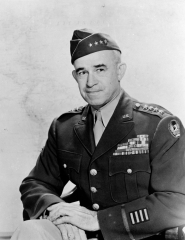Omar N. Bradley

Omar N. Bradley
OMAR
N.
BRADLEY
SOLDIER DETAILS
BIOGRAPHY
Omar Nelson Bradley was born near Clark, Missouri, on February 12, 1893. His father was a schoolteacher who died of pneumonia when Bradley was 14; his mother worked as a seamstress and took in boarders to support herself and her son. After graduating from high school, Bradley was working for the Wabash Railroad to earn money to attend college. Though he planned to attend the University of Missouri, his Sunday school teacher urged him to apply to the United States Military Academy at West Point. A talented athlete, Bradley played football and basketball at West Point. He graduated 44th out of a class of 164, which included Dwight D. Eisenhower and many other future generals. Bradley was commissioned as a second lieutenant and posted to the 14th Infantry on the Mexican border, where he supported the U.S. expedition commanded by General John J. Pershing into Mexico in pursuit of Pancho Villa. In 1916, he was promoted to first lieutenant and married his high school sweetheart, Mary Elizabeth Quayle; they would later have a daughter, Elizabeth.
After WW I ended, Bradlwy spent four yeard teaching math at West Point, Elevated to the rank of Major, he was sent for advaced training at Fort Benning, where he intensified his study of miliraty history and tactics. He served a brief tour in Hawaii before he was selceted for mor advanced training at Fort Leavenworkth in 1928. Assigned to the infantry as an instructor Bradley worked with future General George Marsall.
Bradley was in Washington working in the War Department by early 1941, when Marshall sent him back to Fort Benning to assume command of the Infantry School and convert it into a larger-scale, more efficient operation that could train hundreds of officers. After the U.S. entered World War II in December 1941, Bradley—by now a brigadier general—was given the task of training the 82nd and 28th Divisions for combat. At the request of Eisenhower, now supreme commander of U.S. troops, Bradley headed to North Africa in early 1943 to take stock of the then-struggling Allied campaign there and make improvements. Thanks to Bradley’s recommendation, General George S. Patton was given command of the U.S. II corps; as his deputy commander, Bradley helped restore discipline and improve the soldiers’ training. After Patton left for another assignment, he took charge of the corps himself and led it ably for the rest of the North Africa campaign.
Promoted to lieutenant general, Bradley again joined Patton in Sicily, serving as a corps commander in Patton’s Seventh Army. Military journalist Ernie Pyle, who met Bradley in Sicily and became a good friend, memorably dubbed him “the soldier’s general”—later more commonly written as “the G.I.’s general—for his modest style and the care he took for his troops .Eisenhower had chosen Bradley as field commander for American forces during Operation Overlord, the planned Allied invasion of Normandy across the English Channel. Bradley headed to England to train his troops, and on June 6, 1944 (D-Day), he oversaw the first American landings on Normandy’s beaches. He then commanded the First Army and (later) the 12th Army Group during the subsequent fighting against German troops in France, including a pivotal role in the Allied victory in the Battle of the Bulge. By the time the war ended in May 1945, Bradley was a full general in command of 43 divisions and 1.3 million men, the largest group of any American troops to serve under a single field commander. In August 1945, President Harry S. Truman asked Bradley to lead the Veterans Administration (VA), which was organized to provide aid to returning soldiers. In 1948, he returned to the Army as chief of staff, replacing Eisenhower. He would remain in the post only 18 months before he was chosen as the nation’s first-ever chairman of the Joint Chiefs of Staff in August 1949. Elevated to become a five-star general the following year, he served two terms as chairman, overseeing U.S. operations during the Korean War. Courtesy of history.com and mationalww2musuem.com.
 Eisenhower Foundation
Eisenhower Foundation
